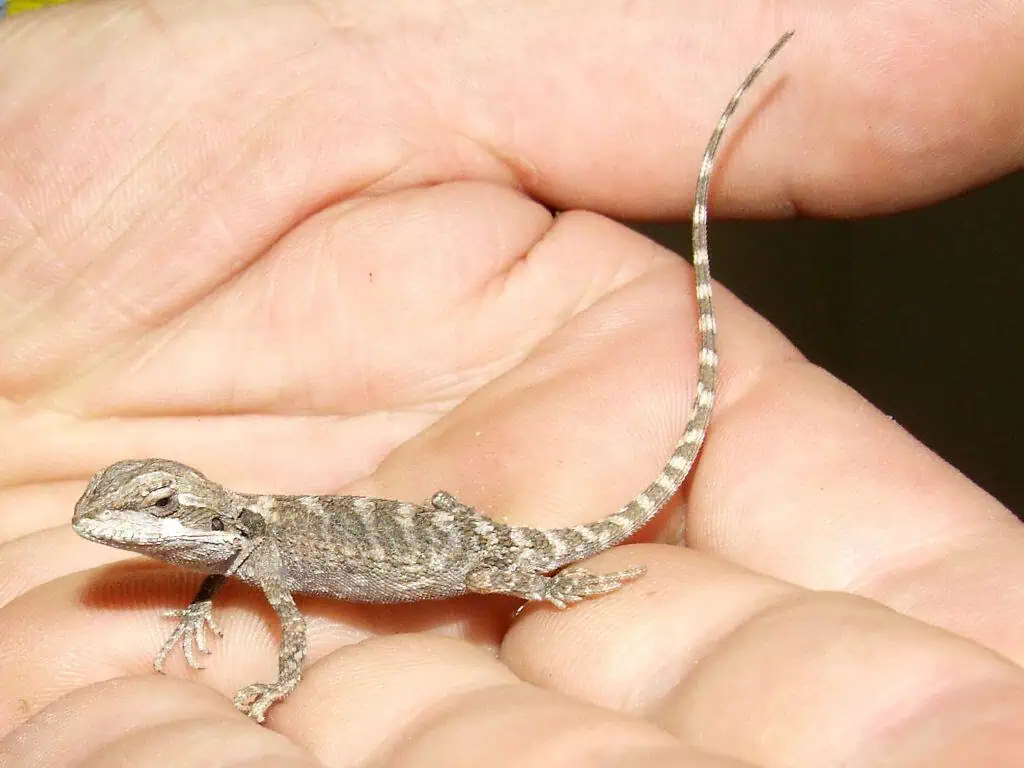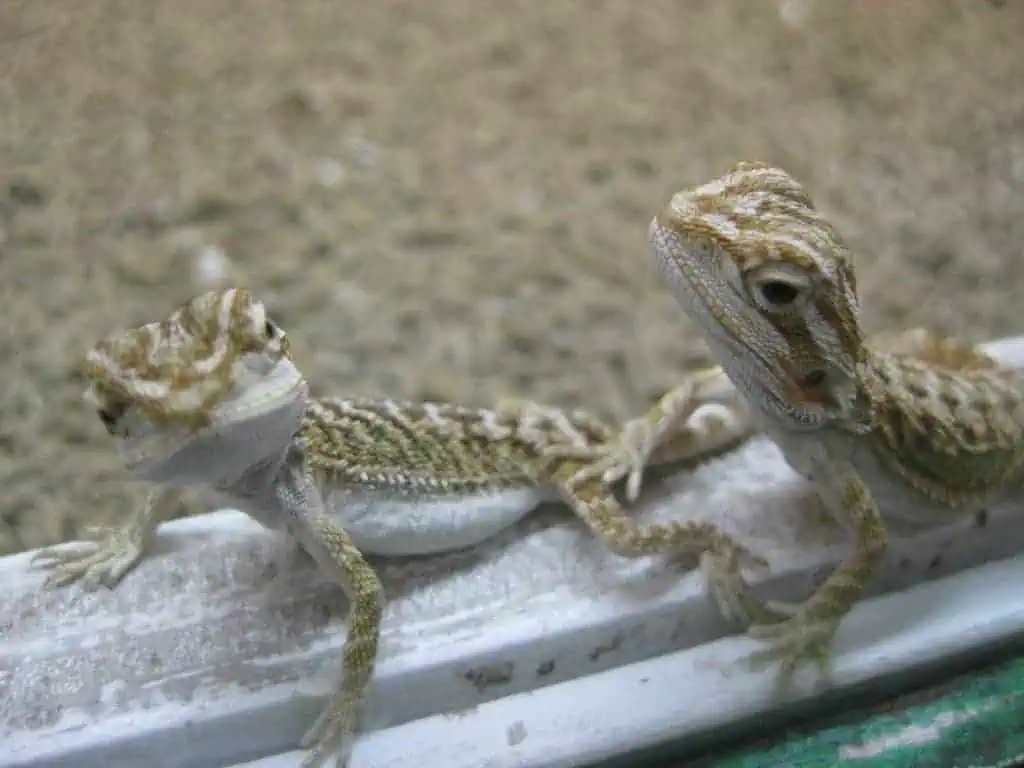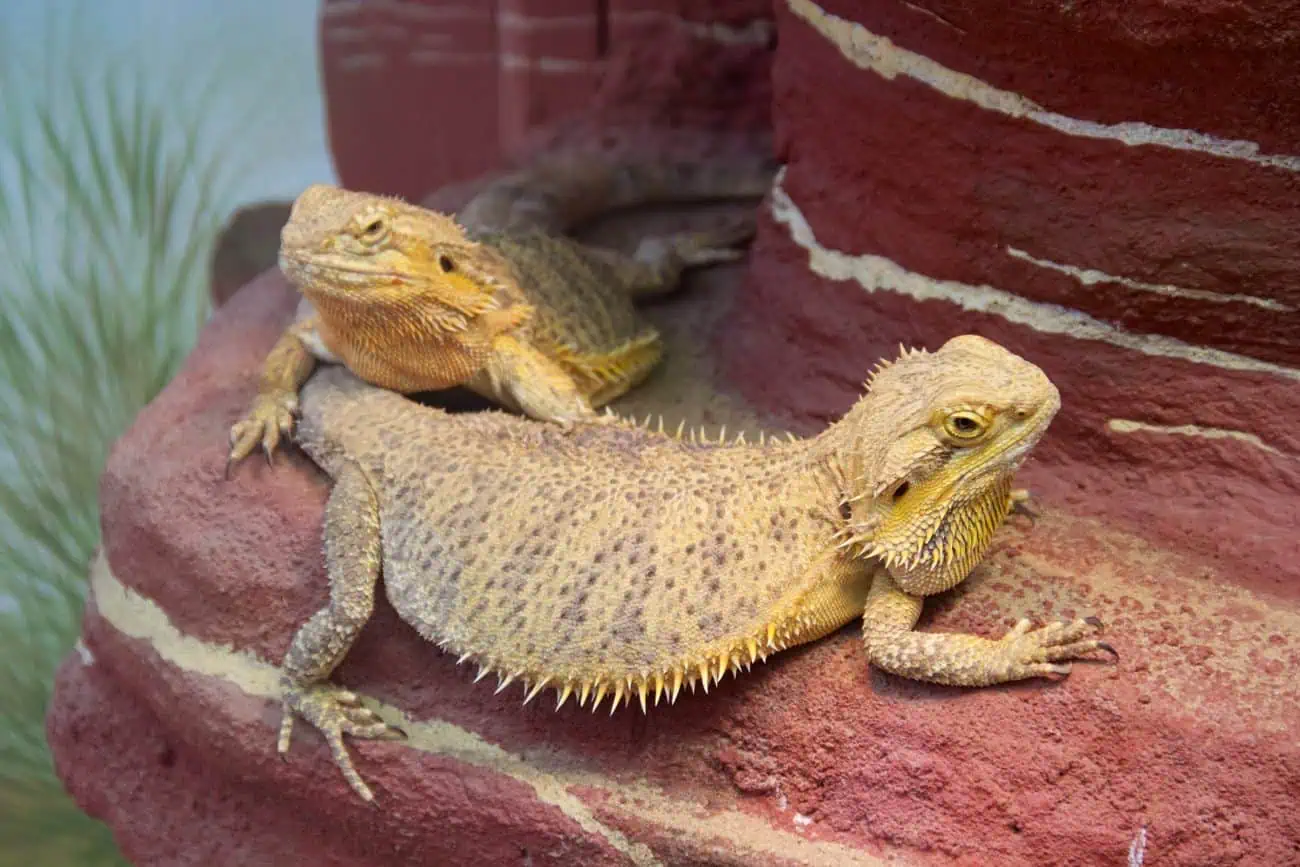One of the basic information about any pet is its sex—whether it’s male or female. Undoubtedly, this goes for bearded dragons as well.
While basic care is almost the same for males and females, various health and behavioral details vary among the sexes, and you should definitely know about them.
Also, picking names and forming pairs if you’re into breeding beardies highly depends on precise sex determination (sexing, for short).
Read on to learn how to sex beardies like a pro.
What Is The Difference Between Male And Female Bearded Dragons?
Mature bearded dragon males and females show many differences in looks and behavior. These distinctions are relatively subtle but still much more apparent than in many other lizards (e.g., skinks)
Male bearded dragons have a bulkier body plan and larger heads. Their throats or “beards” are darker and become jet-black when the dragon is excited or unwell. Male beardies also tend to be livelier and have various specific displays, such as goofy head bobbing.
Female beardies are on the softer side. Their size can vary, but they are generally just a tiny bit more elegant. Their beards never turn black and can only darken (no bearded ladies in the beardie world). As for the behavior, beardie gals are much more chill than males and don’t do any dramatic displays (on the other hand, they are a major trigger for displaying in beardie guys).
However, because individual bodies and behaviors tend to differ, the most certain way to determine whether an adult dragon is male or female is to look at its cloacas.
- Males have two hemipenal bulges on each side above the opening (on the belly side of the line). They can be seen when the tail is lit with a flashlight from the dorsal side of the tail, and you can also feel them by running your fingers over the tail base.
- Males also have a row of femoral pores (looking more like small warts or bumps than pores, aka tiny holes) above the cloaca, running in a line from knee to knee.
- Females lack pores (they are very, very small, to be more precise) and have one central bulge instead of two side bulges. Otherwise, their cloacal region is mostly flat and smooth.
Anatomy of Bearded Dragon Sexes
You may need clarification about cloacas, hemipenes, and femoral pores and what they actually are.
Cloaca is an opening at the base of the tail that serves for excretion (pooping), mating, and egg laying. In simple terms, it is both a genital opening and an anus in one.
The male cloaca also contains two hemipenes—double copulatory organs tucked inside. The only time the hemipenes come out is during mating.
Finally, the femoral pores are small glands that emit pheromones. Males use these pheromones to mark their territory as a part of their mating strategy. Females don’t mark their territories, so it makes perfect sense their femoral pores are insignificantly small.
See how exactly to perform the check below in the Sexing methods.
At What Age Can You Tell If A Bearded Dragon Is Male Or Female?

At the beginning of the last section, the word “mature” is bold. That’s because the listed differences in male and female beardies cannot fully apply to juvenile and baby beardies.
At 12 months (1 year) old, bearded dragons are already mature young adults, and you can tell their sex with certainty.
However, it is possible to sex beardies as young as 8-12 weeks, but the possibility of making a mistake is bigger. Sexing beardies that are so young is better done by a breeder or an experienced bearded dragon hobbyist. Despite their best intentions, regular pet store staff may not have enough knowledge or hands-on experience to get it right.
Unless you are looking for beardies to establish a bearding program, an error in sexing bearded dragons is not the end of the world.
As you’ll see in an upcoming section, caring for male and female beardies is the same, except for some egg-laying associated risks in the gals.
How To Sex A Baby Bearded Dragon?
The only method to try to sex hatchlings and juvenile beardies is by using a lamp to see through their tail to look for hemipenes.
You can see the details below in the Methods, but the point is to look at the lit tail from the underside and look for two dark, elongated shadows at the base of the tail. These are the hidden hemipenes tucked inside the body. If no such shadows are visible, the beardie is likely a female.
Methods To Tell If Your Bearded Dragon Is Male Or Female
There are a few measures you have to have in mind before sexing a bearded dragon.
- Ensure that your beardie is relaxed and not stressed out. Doing cloaca checks on a lizard that has already been agitated will just make his situation worse.
- Also, avoid doing the check right after feeding to prevent possible regurgitation.
- You should be relaxed, too! Human nervousness during sex checks can easily lead to accidents.
- Make sure you are holding your lizard above a safe surface in case it suddenly jumps or gets away. I don’t recommend doing the check in the air right above the floor.
- Never hold a beardie by the tip of its tail – you might break it.
Sexing Adult Bearded Dragons
- Rest the beardie on the palm of your non-dominant hand.
- The easiest way is to put the other palm on your beardie’s back and then turn him or her (we don’t know yet!) belly side up so you can inspect femoral pores and the cloaca.
- If your beardie struggles too much when you turn him upside-down, don’t push it. Instead, slowly lift him into your viewing plain, lift the tail at about 90 degrees, and look underneath.
- Look for pores and bulges.
- If you want an additional check, ask someone to shine a flashlight through the tail (from its back side) to look for the hemipenes on the sides of the tail. This method, called candling, works best in the dark.
Sexing Baby Bearded Dragons
- Hold the baby dragon securely and gently for a few moments before proceeding.
- A one-hand technique used by breeders is to gently take the neck and shoulder area between the index and middle finger of your hand and then raise and flip the tail slightly with the thumb of the same hand to see the cloaca clearly.
- After you got your baby beardie into position, with your other hand, shine a flashlight through the tail (the light should come from the back side of the tail).
- Look for either two bulges on the sides of the tail (male) or one central bulge (female).
- If you don’t feel secure performing the check by holding a beardie with one hand, feel free to use both (one to hold the baby and one to lift the tail) and have somebody assist by holding the lamp.
Since the differences are discrete, I wholeheartedly suggest that you watch a few videos on the topic to observe how those differences look in better detail.
What’s The Difference Between Keeping Bearded Dragon Males And Females?
As I already mentioned, there is no significant difference between owning a beardie male vs. a female. Basic care is pretty much the same. So, if your beardie has been sexed wrongly and you’ve found out that you actually have a female instead of a male (or vice-versa) when your pet grew up, it is no big deal. Since I know no cases of people painting a reptile room according to their beardie’s sex, the only hassle you’ll likely go through is to change or modify your beardie’s name.
Here’s what’s different about keeping female beardies vs. male beardies.
Egg Binding In Females
Female lizards in captivity—and especially those that are well-cared for—often lay eggs even if they are not bred and even if they don’t have a male around. Some individuals are more prone to male-less ovulation than others, so there are no guarantees it won’t happen to your female.
These eggs will be infertile and can’t result in baby beardies. However, the same dangers of egg-laying apply to both fertile and infertile eggs.
If your beardie girl has been having appetite issues, a swollen belly and is digging around the enclosure, she is likely preparing to lay a clutch. You can see them in the abdomen if you look at her belly carefully. However, if the female retains the eggs for more than 45 days, unfortunately, she may be egg-bound.
Egg binding basically means that the eggs got stuck for some physiological reason. Calcium deficiency, for example, increases the risk of egg binding, so if you own a beardie female, you want to be extra diligent about providing enough calcium.
Symptoms of egg binding include nesting behavior with no results, lethargy, oversleeping, and simply keeping the eggs in for more than a month since you first noticed they’re there.
Egg binding requires emergency veterinary care, sometimes ending in surgery. If you suspect egg binding, do not wait for it to resolve on its own, and contact a reliable reptile vet as soon as possible.

Two Males – One Big No-No
I have to point it out bluntly: Terrarium Quest does not recommend cohabitation for bearded dragons (or leopard geckos) because the risk of injury is simply too high.
However, I do recognize that there are will always people who are willing to risk it. In some cases, it may not even be planned – for example, some could find themselves in a need to house two beardies together temporarily in case of an emergency (e.g., tank or equipment malfunction or another issue).
In any case, know that bearded dragon males are highly territorial and cannot be housed together with other males, not even for a short while. Fights with hissing, biting, and serious injury are sure to happen. Do not tempt male beardie’s anger and simply never leave them in close proximity.
Housing a male and a female together is also not recommended because the male will stress out the female with courtship and breeding attempts. In a natural setting, a female would have a vast area to run away. In a terrarium setting, that is impossible and leads to high stress.
Sexing mistake in case you bought a bearded dragon for breeding – what to do
Baby beardies are cheaper than mature individuals, especially when it comes to high-end bloodlines and morphs. That is why many beardie enthusiasts looking to start breeding programs still opt to buy baby dragons. However, that decision comes with a risk of wrongly sexed lizards.
Many breeders state on their websites that they do not offer guarantees about the sex of baby beardies they sell. If there is such a statement on their web pages, it means that you can’t count on a refund if the sex of your ordered baby turns out to be wrong, even if the beardie has already sexed the beardie.
To avoid unpleasant experiences on both sides, always ask the breeder (or a store) in advance what their policy on sexing mistakes is. Once you have a clear picture, it is much easier to sort out future inconveniences (or to opt for another breeder).
Take Care!
I hope you now have a clear picture of how to sex beardie dragons and what it takes to do it correctly. When doing reptile sexing, remember to be relaxed, firm but gentle, and well-informed. Do your homework, and don’t rely on the sellers to be 100 percent correct about your new pet’s sex.
Have any questions left? Feel free to drop a comment below – we’ll reply ASAP.


